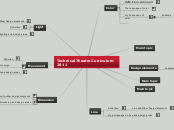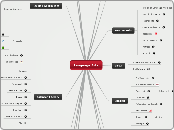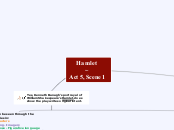Technical Theatre Curriculum 2011
Dimension
My philosphy on dimension and design areas
• Dimension is scale and relationship.
• What is the design area in scale to all the aother techinical aspects. Example costume heavy but sound light.
• Dimension is also size relationships--huge sets but diminutive costumes
• Dimension in make-up. Symmetry or Imbalance. What features need to be bigger, what features need to be smaller. We use light, shadow, color, line, texture to create dimension in make-up
• Dimension in sound (please remember that sound is not a true visual art) is volume and direction. We can make the size of the set expand through a huge thunderstorm or shrink with hum of an electrical appliance. We can make some character's louder or more defined through equalization.
• Dimension in costume is the size and shape of the costume in proportional relation to the actor and the space. Design may call for huge elaborate 18th century gowns or skin tight body suits.
• Dimension in set design and painting is compositional elements on how the performance space fits together. Dimension is also inextricably tied to the actual design plant of the theatre itself. What is possible in the sense of dimension. So dimension is measurement--dimension is huge (nice pun) in the world of construction and painting.
Dimension and relationship to other design elements
• Dimension is achieved through use of Color, Light and Texture.
• Dimension can produce a prominence or recession by color, texture, and light choices.
• In the arena of proportional relationships create a rhythm or a sense of movement
Dimension in sound involves level, dynamic, genre, speaker placement, equalization, and the relationship between these elements--proportion.
• Dimension is the size and mass of form.
• Dimension is not only concerned with size of a shape or the mass of a three-dimensional form, but also with the relationship of the size of one shape to another
• small to large--small to small--massive to miniscule
• Real dimension is always apparent in 2-Dimensional forms ,but like line, can be suggested by a 3-Dimensional representation on a 2-D form
• Dimension is also the amount of space between forms in a compostion
• Dimension has a proportional relationship in size intervals
Movement
My philosophy on movement and design areas
• Movement is how the audience can see and experience the dynamic relationships between actor and environment. It is also an important element when it comes to practical application of design. Movement is the flow, the experience, and the energy of design.
• Movement in Lighting can be real in use of area lighting or even special effect lighting. It can be simulated in subtle changes in time of day or mood. Lighting in its power of illumination is the key design element that dictates optical engagement (eye focus).
• Movement in Costuming is a very practical aspect in theatre design, due to the tremendous demands for actor movement. Costuming as the actors second skin needs to match the movement needs of the character and also the inner development of how the character interacts with the social and actual enviroment. Movement is also involved in fabric choices from the heaviness of wool to the freedom of chiffon.
• Movement in make-up could be as practical as making sure a prosthetic doesn't impede speech to changing the overall focused features of the actors face--emphasis on eyes of the young hero to the fierce troubled brow lines of the villian.
• Movement in set is huge. In composition you want to make sure that the audience is not taken away from actor or situation by poor composition choices--like a poorly porportioned backdrop or confusing line choices or colors. You want to direct the movement to central focal points with proper set devices. Movement is also key for set changes and actor entrance and exits. A set with good movement choices will be a better show blocking(actor movement on stage) wise for the actors usually.
• Movement in sound can be as practical as music for scene changes to as complex as speaker placement and a series of designed sound effects throughout the auditorium. Sound movement does involve actor with lavaliere and stage placed microphones.
•
•
•
Movement and its relationship to other design elements
• Movement is created through use of simulated line as it stimulates optical motioan as the eye is led from one shape to the next.
• Movement is intuitive in the world of orientation
• Like line, movement is controlled by strong direction being reversed, countered, or subtly changing direction by position, light, and color.
• Movement is achieved by contrast. A static object place with a busy pulsating background can achieve movement.
• Movement can be a distracting element that must be controlled in context to blocking, lighting, color, and scenery
•
Definiton
• Movement is the action of form
• The kinetic energy of composition
• Every composition has movement even in a static design.
• Movement is the pattern of optical signals from the retina to the brain--it is the continuous flow of stimulus so mobile in nature
• Real movement in stage design involves the actors, lighting, and at times animated scenery-or actual moving-revolving scenery.
• Simulated movement is represented in design sketches as movement lines for a costumes, or shock waves.
• Optical movement (eye movement) is created through a fixed arrangement of forms.
Light
My philosophy on lighting and design areas
• Lighting is the life of design.
• Light is intrinsic with color theory.
• The absence of light creates shadow.
• Lighting in set design involves direction and dimensionality. All color choices in the set must work in combination with color choices in lighting.
• Lighting in sound is usually a running of the show collaboration. Sound cues and lighting cues are oftened paired together and has much to do with the overall timing and movement of the show.
• Lighting in make-up is a key element. All make-up design is the knowledge of light and shadow. Light is the high lighting element and paired with shadow is one of the make-up designers major concerns.
• Lighting in costume involves how costumes will interact with stage lighting color. Also the idea of light colors and transparency has its place in costume design as well.
• Lighting is lighting for lighting design. There is much to learn about this discipline.
•
•
•
• Light reveals form
• Light is the most dominate presence in all areas of stage design.
• Light should be considered at the beginning of the creative process and not an after thought.
• Light is thought of as real light and simulated light.
• Real light is capable of revealing form as well as a design element on its own.
• Simulated light which is a 3-D representation on a 2-D form.
• Light's own design aspects are intensity, color, distribution, and movement. Light is controlled by its brightness, color, and direction.
• Light and paint similar elements to theatrical lighting.
Lght and Other Design elements
• Light involves all the other design elements
• Light is line as far as direction and distrubution
• Light dictates movement
• Light creates texture and illuminates textural elements on sets
• Light involves color in every aspect of design
• Y
Line
My philosophy on line and design areas
• Line is the beginning and the end to all design aspects--It is the defining element of space and connection to all aspects of theatre
• Make-up--line equals character and shape. We use line in light and shadow to create a human or mystic creature that can jump out of the set, lights, and costume and direct the audience to the actor's instrument.
• Set design-painting--line defines form and creates the backdrop for dimension. It creates the space for the imagination to be. Line confines or frees.
• Lighting line is angular. From the perfect 45 degree to the sharp outline of a gobo to sight lines.
• Sound line is connection. It is the correct line to the correct output. It is the angle of placement.
• Costume line is the flow. How does the curvature of humaness interact with set, light, and movement.
• Line defines form and is the most important force in composition
• Line can enclose space as outline and create space-define space 2-D
• Line can suggest form 3-D as contour line
• Line can be real line many different modes=straight, curved, spiral, etc
• Line can be linear shapes that take on a line-like quality
• Line can be suggested line simulated by the eye as it follows a sequence of related shapes.
Line and Other Design Elements
• Line is the path of action and cannot help but take on a sense of movement
• Linear shapes in arrangement with one another becomes direction--so it must imply movement
• An arrangement of several linear shapes does not only take on direction, but also take on an attitude toward each other, be one of harmony or opposition.
• Line is a dynamic force in any technical theatre design orientation--can create violent action or a stable static force
Design elements
• Line
• Dimension
• Movement
• Light
• Color
• Texture
Main topic
Color
My Philosophy of color
My philosophy: Color is life. It is what makes the world beautiful, I love finding either the subtle or the blasting color scheme that will bring the story of the play to life. The complement to the lavender room ( rich combination of marbles that I invented to get the right one that will enhance the lusciousness of Victorian extrava-gance . Color define energizes form. Color creates line or breaks line. color creates richness or starkness. Color is the emotion of life. Telling our story like few mediums can. Color could be the beginning and also the ending of all artistic endeavors. I strong believe that color is taste.
Subtopic
The language of color
Language of color is what all artists and designers use to communicate his or her artistic idea. Many artists create their own preferences when it comes to color. Color also evoke psychological affects when in combinations. For instance think about if this classroom was painted a dark ugly green? How would that affect how you felt about being in the classroom. Color is normally never in isolation it comes in combination( yes even in a mono-chromatic color scheme--shades and tints. There is color choosing software to help all kinds of designers. There is all kinds of color theory and we need to know how color works in our discipline (theater)
Definition continued
Theatre color comes from 2 basic sources -pigment and dye
-Value is a medium of color itself in the using suggested shades and highlights using black and white tones. Value is expressed through black and white sketches in the early process of design many times.
--
Definition
• Color modifies form
- Color is a powerful stimulus that
1. can change the dimension of form
2. reverse the direction of line
3. alter the interval between forms
4. generate optical motion









